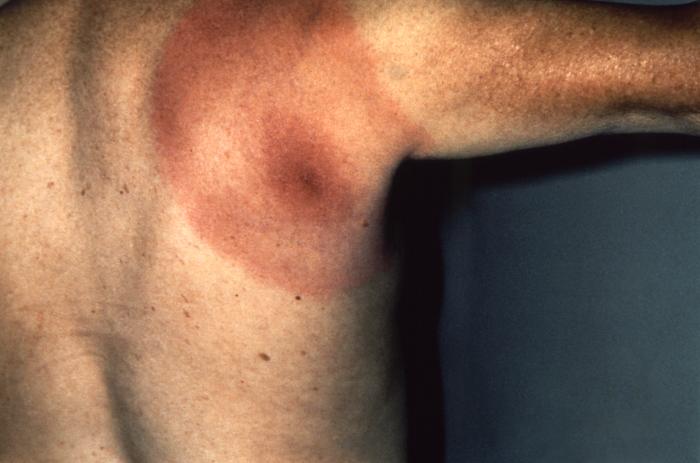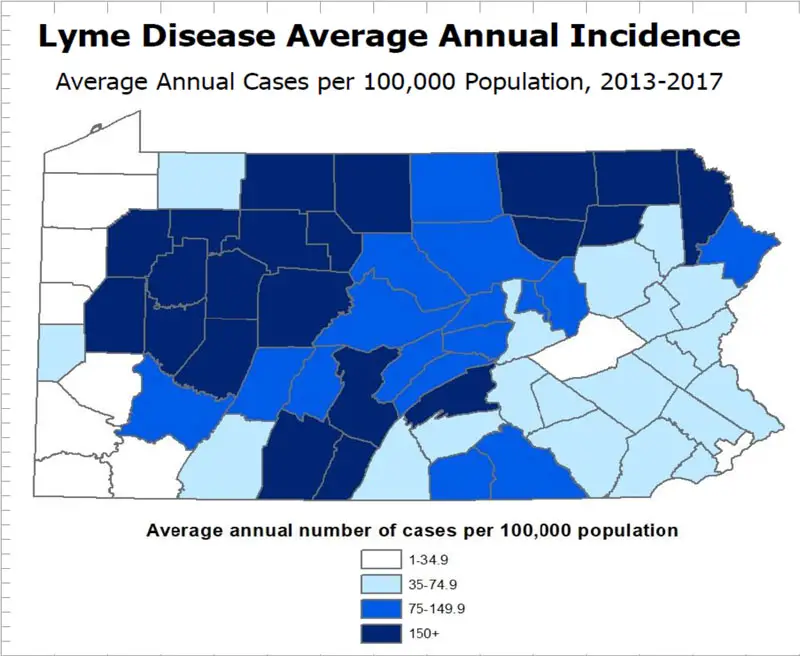 JEFFERSON CO., Pa. (EYT) – With the highest number of cases in the nation since 2000, the continuing rise in Lyme Disease is a serious concern in Pennsylvania, as well as our region.
JEFFERSON CO., Pa. (EYT) – With the highest number of cases in the nation since 2000, the continuing rise in Lyme Disease is a serious concern in Pennsylvania, as well as our region.
(Photo courtesy Centers for Disease Control and Prevention)
According to data from the Pennsylvania State Department of Health, Lyme Disease continues to be a growing problem through much of Pennsylvania.
As of the most recent statistics gathered, from 2017, Jefferson County has the highest incidence rates in the region at a rate of 658.00 per 100,000 people.
A map provided by the State Department of Health shows that Jefferson County sits in the middle of an area of some of the highest incidence rates in the state.

According to the Centers for Disease Control and Prevention, vector-borne diseases in the U.S. increased more than 300% from 2004 to 2016, and 76 percent of those cases are tick-borne pathogens, primarily Lyme disease.
With the continuing increases and such high incidence rates in the area, Lyme disease is a growing concern.
The bacterium that causes Lyme Disease, Borrelia burgdorferi, is spread through the bite of infected black-legged ticks (also known as deer ticks).
According to Kayla Lewis, a Medical Assistant at Primary Care Associates of Western Pa. in Brookville, one of the things many people don’t realize is that a tick that is attached for less than 24 hours is unlikely to transmit Lyme disease.
“We typically say it has to be 24 to 48 hours before you have a chance of getting Lyme disease,” Lewis told exploreJeffersonPA.com.
“The most common indication of Lyme Disease is the bullseye rash, but not everyone gets that.”
The circular rash called erythema migrans, more commonly known as “bullseye” rash, can begin as small as two inches and can gradually reach up to 12 inches. The rash usually appears anywhere from three days to a month after being bitten.
Other symptoms can include fever, fatigue, headaches, muscle aches, and joint pain.
The treatment for Lyme Disease is antibiotics, most often doxycycline, though other options include amoxicillin or cefuroxime axetil. People treated in the early stages of Lyme Disease usually recover completely; although in some cases, symptoms such as fatigue and muscle aches can last for over six months.
“One of the biggest factors, if it goes untreated, is joint pain and arthritis,” Lewis noted.
The National Institutes of Health (NIH) has funded a number of studies on Lyme Disease and the treatments, including clinical research efforts addressing multiple aspects of the disease and “Post Treatment Lyme Disease Syndrome” (PTLDS), in which the patients’ symptoms persist after treatment.
Nevertheless, while the treatment for Lyme Disease is generally effective, avoiding infection in the first place is always preferable.
“Prevention is the best treatment,” Dr. Posnick noted.
The Pennsylvania Department of Health recommends treating clothing and gear with products containing 0.5% permethrin and using Environmental Protection Agency (EPA)-registered insect repellents containing DEET, picaridin, IR3535, Oil of Lemon Eucalyptus (OLE), para-menthane-diol (PMD), or 2-Undecanone.
After being outdoors, particularly in grassy, brushy, or wooded areas, always check your clothing, gear, and pets for ticks and shower within two hours, taking time to check your entire body for ticks and immediately removing any that you find.
If you do find a tick, it can be removed using fine-tipped tweezers. The tick should be grasped as close to the surface of the skin as possible and pulled straight up with steady pressure. Never jerk or twist when removing a tick as it can cause the mouth-parts to break off and remain in the skin. After removal, the bite should be cleaned with soap and water or rubbing alcohol.
According to the CDC, vector-borne diseases in the U.S. increased more than 300% from 2004 to 2016, and 76 percent of those cases are tick-borne pathogens, primarily Lyme disease.
Locally, every county in our region has seen an increase in incidence rates in recent years as shown below.
Regional Incidence Rates Per County from 2011 to 2017:
– Armstrong County: 212.93 per 100,000 in 2011 to 323.38 per 100,000 in 2017;
– Clarion County: 94.97 per 100,000 in 2011 to 514.11 per 100,000 in 2017;
– Forest County: 65.88 per 100,000 in 2011 to 400.76 per 100,000 in 2017; and
– Jefferson County: 240.13 per 100,000 in 2011 up to 658.00 per 100,000 in 2017.
As the statistics indicate, Jefferson County’s Lyme Disease incidence rate rocketed in a short time span making it a serious health concern for the area.
While the NIH, the DCD, and the Pennsylvania Department of Health are concerned with the increases in Lyme Disease, the reasons for the increases are complicated.
According to the CDC, increases in Lyme disease have been linked to changes in land use patterns, including reforestation and suburban development. Changes in climate patterns can also have effects on the natural environment and ecological relationships, which in turn can affect vector-borne diseases like Lyme Disease.
Copyright © 2024 EYT Media Group, Inc. All rights reserved. Any copying, redistribution or retransmission of the contents of this service without the express written consent of EYT Media Group, Inc. is expressly prohibited.









